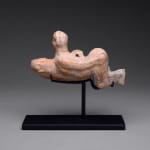Roman Oil Lamp in the Form of an Ithyphallic Man, 1st Century CE - 3rd Century CE
Terracotta
7.6 x 11.4 cm
3 x 4 1/2 in
3 x 4 1/2 in
CK.0036
Further images
The rediscovery and subsequent excavations of Pompeii and Herculaneum in the 18th century provided many fascinating insights into daily life during the height of the Roman Empire, including the near...
The rediscovery and subsequent excavations of Pompeii and Herculaneum in the 18th century provided many fascinating insights into daily life during the height of the Roman Empire, including the near ubiquity of erotic or sexually themed art and imagery in frescos, inscriptions, and household goods found throughout the cities. While our modern mores may lump all of this imagery together under the banner of pornography, to the Ancient Romans some of this work may have served a fertility function, while other was clearly meant to be for pure erotic pleasure. Among the most famous imagery are the frescos found decorating the walls of a brothels, perhaps representing a selection of services offered at the establishment, perhaps merely setting the mood. Beyond the scope of these two cities, the canon of Roman art is filled with eroticism, from marble sculptures to small bronze amulets. Among the most prevalent are examples are terracotta oil lamps decorated with molded scenes of copulating couples in a variety of positions and practices.
This terracotta oil lamp depicts a young man bent over. His legs and knees are pressed together and he reaches back with his arms, grasping his buttocks and spreading them apart. From underneath his torso emerges his grossly exaggerated erect phallus, which projects forward past his shoulders and serves as the spout for the lamp. There is a small loop in the center of his back, between his buttocks and head, indicating the lamp originally would have hung from the ceiling. Although such an image may seem lewd and improper today, it clearly demonstrates the openness of Ancient Roman sexual mores.
This terracotta oil lamp depicts a young man bent over. His legs and knees are pressed together and he reaches back with his arms, grasping his buttocks and spreading them apart. From underneath his torso emerges his grossly exaggerated erect phallus, which projects forward past his shoulders and serves as the spout for the lamp. There is a small loop in the center of his back, between his buttocks and head, indicating the lamp originally would have hung from the ceiling. Although such an image may seem lewd and improper today, it clearly demonstrates the openness of Ancient Roman sexual mores.







